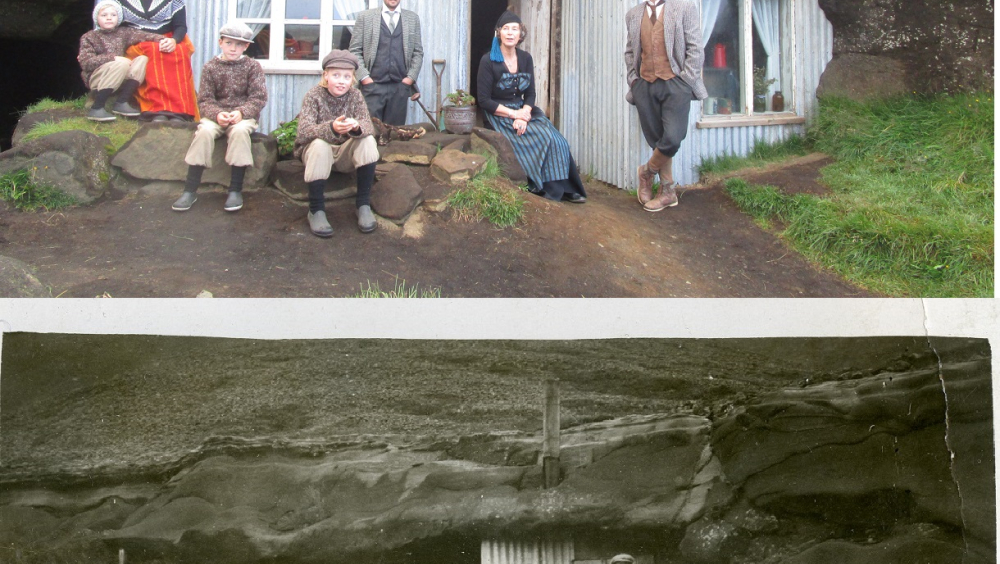The Cave People
Overview
In 1918 a young couple moved into Laugarvatnhellar, two man made caves. They lived there for 4 years and had 3 children during that time. They wanted to be independant and have their own farm in stead of working for someone else. At that time there were no farms available in the area so the established their own farm in Laugarvatnshellar.
1918 was an eventful year in Iceland. The year started with the coldest winter reportet causing all kinds of problems for the nation. Volcano Katla erupted causing several farms to be deserted. The Spanish flu came to Iceland in october causing hundreds of deaths. But the year wasn´t only bad because Desember 1st Iceland became a sovereign state. This year a young couple decided to move in to a cave. They were Icelands last cave dwellers and this is their story.
Jón Þorvarðsson and Vigdís Helgadóttir moved into Laugarvatnshellar in the summer of 1918, they were newly married and wanted to be independent farmers instead of working for someone else. Jón was a handy man so he closed the caves with well built walls and made a hole in the ceiling for the chimney from their stove. Their cave dwelling was a temporary solution untill they found something else. They grew potatoes, had around 25 sheep, a cow and a couple of riding horses. The caves are two, side by side. The sheep and the horses were in the smaller cave while the bigger one was divided into two rooms, the cow was kept in the inner room but the people lived in the outer room. In april 1919, less than a year after the couple moved in Vigdís gave birth to their first daughter Ragnheiður in the cave. At that time there had been bad weathers with alot of snow so the midwife, that was suposed to be there, hadn´t been able to come. There was therefore nothing else to do but for Jón to delivere his baby him self. After delivering the baby there were some complications getting out the placenta. To save his wife and daughter Jón had to leave them in the cave and go get help. Jón went out with his horse and after having struggled in the hard weather conditions for 8 hours he came back with a midwife whitch was able to take out the placenta. Before the family moved out in 1922 they had become 5. Besides doing the farmwork they also sold coffee and cake to people passing by. Since the caves are on the route from Reykjavik to Geysir (in the middle of what we today call the golden circle) many people passed by and some of them stoped for a coffee. The most known person to stop at the caves is with out a doubt King Christian X of Denmark, he came by when he visited Iceland in 1921 and Vigdís served him some skyr (a traditional Icelandic dairy product) with cream. After the family moved out no one has lived in the caves but people have stopped their and tried to imagine how it must have been to have lived there. In 2017 a small family business did some research about the cave dwelling by reading articles about it and talking to their descendants. The bigger cave (where the family lived) was renovated so today it looks the same way it did 100 years ago. People can now visit the caves and go back 100 years in time to expeerience how Icelands last cave dwellers lived and here their story told in more detail by a guide. You can find out more about this by visiting the website thecavepeople.is
European Dimension
Laugarvatnshellar caves are man made but there are no sources that can confirm who made them. One theory claims they were made by Irish monks that are suposed to have been in Iceland before the Norse settlement in the late 9. century. After the settlement Laugarvatnshellar were used as shelter for shepherds and other people travelling in the area. There are many folk tails about elves and hidden people from the caves. The caves are dug into tuff stone whitch is soft and easy to carv in. The walls and ceiling have carvings telling the story of Iceland maybe even older than the Norse settlement. There might be carvings made by Irish monks, shepherds, Danish Kings and lonly travellers writing the name of the love of their lives. Laugarvatnshellar caves tell a story of the urge of the Europeans to travel and discover new land and how peoples lifes evolved in the last 1000 years.
